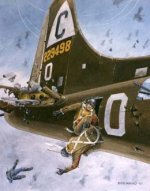 |
Joseph Sawicki Story |
Personnel
Mission Reports
Story artwork by Robert A. Hand, Sr.
 During World War II, acts of self-sacrifice and heroism often went
unnoticed or unheralded in the intense head of battle. . . such are
the conditions of war. Driven to split-second decisions in the most explosive
of emergencies the least likely soldiers have committed extreme acts of bravery
towards their fellows in arms, often with their last ounce of strength, some
never to be remembered or recognized. This is the story of one such person,
a B-17 tail gunner named S/Sgt. Joseph Sawicki of Detroit, Michigan.
During World War II, acts of self-sacrifice and heroism often went
unnoticed or unheralded in the intense head of battle. . . such are
the conditions of war. Driven to split-second decisions in the most explosive
of emergencies the least likely soldiers have committed extreme acts of bravery
towards their fellows in arms, often with their last ounce of strength, some
never to be remembered or recognized. This is the story of one such person,
a B-17 tail gunner named S/Sgt. Joseph Sawicki of Detroit, Michigan.
In the tail section, S/Sgt. Joseph Sawicki was struck by the flak burst that
tore away his left arm below the elbow and that also inflicted mortal wounds
to his midsection. Bleeding profusely and in unimaginable pain, he crawled
forward to the waist section to find both waist gunners, Sgt. Fisher and S/Sgt.
Marty Stachowiak, wounded and dazed on the floor of the aircraft. They had
suffered multiple wounds and each had a broken arm.
With his last ounce of energy, he managed to buckle a chest pack chute
on each and drag them to the waist door. Pulling the hinge-pin cable, he kicked out
the door and wrestled both gunners to the exit, literally booting them out
of the faltering aircraft into the minus 50 C air outside. They were
able to pull their own ripcords and safely parachuted into enemy territory.
Sgt. Sawicki collapsed from his wounds and went down with the
flaming Fortress.
Repeated attacks by Focke-Wulf 190 fighters sent 20mm cannon shells tearing through the
Fortress. Lt. Fyler was wounded and his co-pilot Lt. Bob Ward was
hit in the face and lost an eye. The engineer, T/Sgt. Bill Addison, in the
top turret, was blasted out of his position with a torn leg. The navigator,
Lt. George Molnar was wounded in the back, but the Bombardier, Lt. Jom Petrolino
miraculously escaped injury. The ship fumed violently with
part of the right wing and two engines dead. A hail of cannon fire
from the attacking fighters flamed another engine and after a futile, 20
minute struggle to control the stricken aircraft, the pilot gave the order
to bail out. The forward crew members escaped through the open
bombay. Fyler snapped on his chest pack chute and dove to the
hatch below and seeing that the nose section was empty, dropped
out of the plane.
Yet another sweep of the determined Luftwaffe pilots sent explosive
shells screaming through the B-17s midsection, leaving huge
holes in the radio room and ripping
open the bombay fuselage. Caught
in the midst of the explosions was
radioman Sgt. O'Connell.
With split seconds to spare, he
made his way forward to the open
bombay and along with NPS Egge,
the wounded photographer,
dropped from the crippled Fortress.
Sgt. Ray Ford was dead in the disabled ball turret and his body went
down with the aircraft.
S/Sgt. Sawicki's remains were
buried near Bremen and were later
disinterred and moved to a stateside burial
ground in Detroit, Michigan. Sawicki flew 14 missions in
1942 with the Polish RAF and wore
the Polish Cross of Honor and the
Polish Legion of Merit.
Of the heroic crew of 11 that day,
ten were wounded and four died immediately and
three succumbed later to POW mistreatment. Lt. Fyler
was repatriated at the War's end in
1945, promoted to Captain and later Major. He was awarded the
Distinguished Flying Cross and the Air Medal with clusters.
He is now a retired dentist living in Topeka,
Kansas and is president of his local POW Chapter.
His book, "Staying Alive" tells of this and other incredible wartime
experiences.
Note from Hal Susskind,
President of the 303rd BGA:
Carl Fyler's account of
the November 29, 1943 mission to
Bremen was first published under
the title "Staying Alive" in the July
1989 issue of the "Hell's Angels
Newsletter."
In that story, Fyler related how
he was liberated from the POW
camp in May 1945 and later met
up with Sgt. Stachowiak in the
hospital at Camp Lucky Strike in
France. It was in that conversation
that Fyler heard about Sgt. Sawicki's heroic act.
After hearing Sgt.
Stachowiak's hospital-bed story,
Capt. Fyler, at RAMPS Camp
Lucky Strike, France in July 1945
wrote up a narrative recommending Sgt. Sawicki for a posthumous
award of the Congressional Medal
of Honor. Another recommendation
was made in 1947. Both were lost
and no action taken. Fyler is continuing his attempt to get the
award Sgt. Sawicki deserves . . .
In 1995, I wrote a letter to the
then Chairman of the Joint Chiefs
of Staff, Gen. Colin Powell, seeking his support in getting the
award for Sgt. Sawicki. Unfortunately my letter, which started at
the top, found its way back down to
a Major in the US Army. He essentially
said that we would need a person
who witnessed the act of
heroism to verify that the act had
actually happened the way it is described.
Since Stachowiak died in
1975 and Fisher much earlier, our
quest to right a wrong has hit a roadblock.